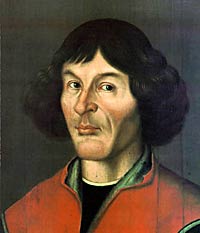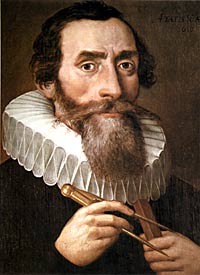Readings:
Psalm 8
Genesis 1:14-19
1 Corinthians 2:6-12
Matthew 2:1-11aPreface of God the Father
[Common of a Scientist or Environmentalist]
[For Scientists and Environmentalists]
[For Space Exploration]
PRAYER (traditional language)
As the heavens declare thy glory, O God, and the firmament showeth thy handiwork, we bless thy Name for the gifts of knowledge and insight thou didst bestow upon Nicolaus Copernicus and Johannes Kepler; and we pray that thou wouldst continue to advance our understanding of thy cosmos, for our good and for thy glory; through Jesus Christ, the firstborn of all creation, who with thee and the Holy Spirit livest and reignest, one God, for ever and ever. Amen.
PRAYER (contemporary language)
As the heavens declare your glory, O God, and the firmament shows your handiwork, we bless your Name for the gifts of knowledge and insight you bestowed upon Nicolaus Copernicus and Johannes Kepler; and we pray that you would continue to advance our understanding of your cosmos, for our good and for your glory; through Jesus Christ, the firstborn of all creation, who with you and the Holy Spirit lives and reigns, one God, for ever and ever. Amen.
This commemoration appears in A Great Cloud of Witnesses.
Return to Lectionary Home Page
Webmaster: Charles Wohlers
Last updated: 23 March 2019
NICHOLAS COPERNICUS and JOHANNES KEPLER
ASTRONOMERS, 1543 & 1630
 Nicola(u)s Copernicus (Mikolaj Kopernik) was born in Poland in 1473. His parents died when he was twelve, and he was entrusted to his uncle (soon to be the Bishop of Ermland), who sent him to the University of Cracow (astronomy) and then to Bologna (Greek, mathematics, Plato) and Padua (law and medicine) and Ferrara (Doctor of Canon Law). Having been elected a canon of Frauenberg Cathedral, he returned home, assisted his uncle until the uncle's death, and then opened a free clinic for the poor.
Nicola(u)s Copernicus (Mikolaj Kopernik) was born in Poland in 1473. His parents died when he was twelve, and he was entrusted to his uncle (soon to be the Bishop of Ermland), who sent him to the University of Cracow (astronomy) and then to Bologna (Greek, mathematics, Plato) and Padua (law and medicine) and Ferrara (Doctor of Canon Law). Having been elected a canon of Frauenberg Cathedral, he returned home, assisted his uncle until the uncle's death, and then opened a free clinic for the poor.
His interests were many and varied, including theology, poetry, and the natural and social sciences. He is the first known formulator of what we now call Gresham's Law ("Bad money drives out good" -- that is, if there are two kinds of coins in circulation that have the same legal or face value, but one is more valuable in terms of its content (say a silver dime and a cupro-nickel "sandwich" dime), consumers will tend to hoard the more valuable coins and spend the less valuable ones, so that soon only the less valuable ones will be in circulation).
He is chiefly remembered, however, for his work as an astronomer. In his day, the common view of the world was the geocentric model -- the theory that the earth was a motionless sphere and that the heavenly bodies all revolved around it. There was a minority view: Cardinal Nicholas of Cusa, for example (Papal legate to Germany, who by careful measurements showed that a growing plant did not derive its increased mass principally from the soil, but rather from the air, and who died a century before Galileo was born) wrote: "When we say that the earth does not move, we mean simply that the earth is the point with reference to which man makes his observations of celestial phenomena." But, by and large, the stability of the earth, backed by what was thought to be good scientific evidence, was the view that prevailed. (It is often said that medieval Christians thought that the earth was flat, but that is pure hoax. Dante, writing in the early 1300's, refers to the earth as a sphere, and so does Thomas Aquinas in the opening section of the Summa Theologica, and so does Bede in the early 700's, and so does Irenaeus in the late 100's. The issue was not shape but motion.)
The geocentric model had been interwoven with other theories in chemistry, physics, music, natural theology, and other disciplines, into one unified theory of nature, so that it seemed that rejecting any single part (such as the stability of the earth) imperilled the whole theory. However, as the astronomers of the day measured the motions of the heavenly bodies with increasing accuracy, and the theory was patched up to fit the measurements, it became an increasingly awkward theory. Copernicus proposed to simplify it by supposing that the sun, not the earth, was at the center. He first produced a summary of his theory in 1530 in a paper called the Commentariolus, which received papal approval. He then spent the next thirteen years revising it, expanding it to book length, rechecking his calculations, rewriting his arguments, postponing publication until he was sure that he had not overlooked something. (Some writers today will know the feeling.) Finally, he entrusted it to an old pupil, Georg Rhaeticus, a professor at Leipzig, who published it there, with a preface added by the Lutheran pastor Osiander stating that the heliocentric model was only a device to simplify computations. The printed book, called De Revolutionibus Orbium Caelestium (The Revolutions of the Heavenly Bodies), was brought to Copernicus only a few hours before his death 24 May 1543.
His work roused little opposition at first, but when Galileo quarreled with the University establishment in Italy and finally with the Pope, the whole geocentric model fell under suspicion and Copernicus's book was placed on the Index "donec corrigetur" ("until it be corrected") from 1616 to 1758.
 Johannes Kepler (December 27, 1571 – November 15, 1630) was a German mathematician, astronomer and astrologer, and key figure in the 17th century scientific revolution. He is best known for his eponymous laws of planetary motion, codified by later astronomers based on his works Astronomia nova, Harmonices Mundi, and Epitome of Copernican Astronomy. They also provided one of the foundations for Isaac Newton's theory of universal gravitation.
Johannes Kepler (December 27, 1571 – November 15, 1630) was a German mathematician, astronomer and astrologer, and key figure in the 17th century scientific revolution. He is best known for his eponymous laws of planetary motion, codified by later astronomers based on his works Astronomia nova, Harmonices Mundi, and Epitome of Copernican Astronomy. They also provided one of the foundations for Isaac Newton's theory of universal gravitation.
During his career, Kepler was a mathematics teacher at a seminary school in Graz, Austria, an assistant to astronomer Tycho Brahe, the imperial mathematician to Emperor Rudolf II and his two successors Matthias and Ferdinand II, a mathematics teacher in Linz, Austria, and an adviser to General Wallenstein. He also did fundamental work in the field of optics, invented an improved version of the refracting telescope (the Keplerian Telescope), and helped to legitimize the telescopic discoveries of his contemporary Galileo Galilei.
Kepler lived in an era when there was no clear distinction between astronomy and astrology, but there was a strong division between astronomy (a branch of mathematics within the liberal arts) and physics (a branch of natural philosophy). Kepler also incorporated religious arguments and reasoning into his work, motivated by the religious conviction that God had created the world according to an intelligible plan that is accessible through the natural light of reason.
Johannes Kepler's first major astronomical work, Mysterium Cosmographicum (The Cosmographic Mystery, 1596), was the first published defense of the Copernican system. As he indicated in the title, Kepler thought he had revealed God’s geometrical plan for the universe. Much of Kepler’s enthusiasm for the Copernican system stemmed from his theological convictions about the connection between the physical and the spiritual; the universe itself was an image of God, with the Sun corresponding to the Father, the stellar sphere to the Son, and the intervening space between to the Holy Spirit. His first manuscript of Mysterium contained an extensive chapter reconciling heliocentrism with biblical passages that seemed to support geocentrism.
The extended line of research that culminated in Astronomia nova (A New Astronomy)—including the first two laws of planetary motion—began with the analysis, under Tycho's direction, of Mars' orbit. Based on measurements of the aphelion and perihelion of the Earth and Mars, he created a formula in which a planet's rate of motion is inversely proportional to its distance from the Sun; by late 1602 Kepler reformulated the proportion in terms of geometry: planets sweep out equal areas in equal times—Kepler's second law of planetary motion. He then set about calculating the entire orbit of Mars, using the geometrical rate law and assuming an egg-shaped ovoid orbit. After approximately 40 failed attempts, in early 1605 he at last hit upon the idea of an ellipse, which he had previously assumed to be too simple a solution for earlier astronomers to have overlooked. Finding that an elliptical orbit fit the Mars data, he immediately concluded that all planets move in ellipses, with the sun at one focus—Kepler's first law of planetary motion.
Kepler was convinced "that the geometrical things have provided the Creator with the model for decorating the whole world." In Harmonices Mundi (Harmony of the Worlds), he attempted to explain the proportions of the natural world—particularly the astronomical and astrological aspects—in terms of music. Among many other harmonies, Kepler articulated what came to be known as the third law of planetary motion. He then tried many combinations until he discovered that (approximately) "The square of the periodic times are to each other as the cubes of the mean distances." When conjoined with Christian Huygens' newly discovered law of centrifugal force it enabled Isaac Newton and others to demonstrate independently that the presumed gravitational attraction between the Sun and its planets decreased with the square of the distance between them.
In 1615, he completed the first of three volumes of Epitome astronomia Copernicanae (Epitome of Copernican Astronomy). Despite the title, which referred simply to heliocentrism, Kepler's textbook culminated in his own ellipse-based system. The Epitome became Kepler's most influential work. It contained all three laws of planetary motion and attempted to explain heavenly motions through physical causes. It was read by astronomers throughout Europe, and following Kepler's death it was the main vehicle for spreading Kepler's ideas. In the late 17th century, a number of physical astronomy theories drawing from Kepler's work—notably those of Giovanni Alfonso Borelli and Robert Hooke—began to incorporate attractive forces (though not the quasi-spiritual motive species postulated by Kepler) and the Cartesian concept of inertia. This culminated in Isaac Newton's Principia Mathematica (1687), in which Newton derived Kepler's laws of planetary motion from a force-based theory of universal gravitation.
— more at Wikipedia